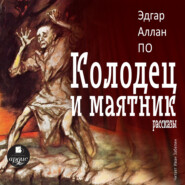По всем вопросам обращайтесь на: info@litportal.ru
(©) 2003-2024.
✖
Eureka & The Unparalleled Adventure of One Hans Pfaall
Настройки чтения
Размер шрифта
Высота строк
Поля
A very slight inspection of the Heavens assures us that the stars have a certain general uniformity, equability, or equidistance, of distribution through that region of space in which, collectively, and in a roughly globular form, they are situated: –this species of very general, rather than absolute, equability, being in full keeping with my deduction of inequidistance, within certain limits, among the originally diffused atoms, as a corollary from the evident design of infinite complexity of relation out of irrelation. I started, it will be remembered, with the idea of a generally uniform but particularly un uniform distribution of the atoms; –an idea, I repeat, which an inspection of the stars, as they exist, confirms.
But even in the merely general equability of distribution, as regards the atoms, there appears a difficulty which, no doubt, has already suggested itself to those among my readers who have borne in mind that I suppose this equability of distribution effected through irradiation from a centre. The very first glance at the idea, irradiation, forces us to the entertainment of the hitherto unseparated and seemingly inseparable idea of agglomeration about a centre, with dispersion as we recede from it –the idea, in a word, of in equability of distribution in respect to the matter irradiated.
Now, I have elsewhere
observed that it is by just such difficulties as the one now in question –such roughnesses –such peculiarities –such protuberances above the plane of the ordinary – that Reason feels her way, if at all, in her search for the True. By the difficulty –the "peculiarity" –now presented, I leap at once to the secret –a secret which I might never have attained but for the peculiarity and the inferences which, in its mere character of peculiarity, it affords me.
The process of thought, at this point, may be thus roughly sketched: –I say to myself –"Unity, as I have explained it, is a truth –I feel it. Diffusion is a truth –I see it. Irradiation, by which alone these two truths are reconciled, is a consequent truth – I perceive it. Equability of diffusion, first deduced a priori and then corroborated by the inspection of phaenomena, is also a truth – I fully admit it. So far all is clear around me: –there are no clouds behind which the secret –the great secret of the gravitating modus operandi –can possibly lie hidden; –but this secret lies hereabouts, most assuredly; and were there but a cloud in view, I should be driven to suspicion of that cloud." And now, just as I say this, there actually comes a cloud into view. This cloud is the seeming impossibility of reconciling my truth, irradiation, with my truth, equability of diffusion. I say now: – "Behind this seeming impossibility is to be found what I desire." I do not say "real impossibility;" for invincible faith in my truths assures me that it is a mere difficulty after all –but I go on to say, with unflinching confidence, that, when this difficulty shall be solved, we shall find, wrapped up in the recess of solution, the key to the secret at which we aim. Moreover –I feel that we shall discover but one possible solution of the difficulty; this for the reason that, were there two, one would be supererogatory –would be fruitless –would be empty –would contain no key –since no duplicate key can be needed to any secret of Nature.
And now, let us see: –Our usual notions of irradiation –in fact our distinct notions of it –are caught merely from the process as we see it exemplified in Light. Here there is a Continuous outpouring of ray-streams, and with a force which we have at least no right to suppose varies at all. Now, in any such irradiation as this –continuous and of unvarying force –the regions nearer the centre must inevitably be always more crowded with the irradiated matter than the regions more remote. But I have assumed no such irradiation as this. I assumed no Continuous irradiation; and for the simple reason that such an assumption would have involved, first, the necessity of entertaining a conception which I have shown no man can entertain, and which (as I will more fully explain hereafter) all observation of the firmament refutes –the conception of the absolute infinity of the Universe of stars –and would have involved, secondly, the impossibility of understanding a reaction – that is, gravitation –as existing now –since, while an act is continued, no reaction, of course, can take place. My assumption, then, or rather my inevitable deduction from just premises –was that of a determinate irradiation –one finally dis continued.
Let me now describe the sole possible mode in which it is conceivable that matter could have been diffused through space, so as to fulfil the conditions at once of irradiation and of generally equable distribution.
For convenience of illustration, let us imagine, in the first place, a hollow sphere of glass, or of anything else, occupying the space throughout which the universal matter is to be thus equally diffused, by means of irradiation, from the absolute, irrelative, unconditional particle, placed in the centre of the sphere.
Now, a certain exertion of the diffusive power (presumed to be the Divine Volition) –in other words, a certain force –whose measure is the quantity of matter –that is to say, the number of atoms – emitted; emits, by irradiation, this certain number of atoms; forcing them in all directions outwardly from the centre –their proximity to each other diminishing as they proceed –until, finally, they are distributed, loosely, over the interior surface of the sphere.
When these atoms have attained this position, or while proceeding to attain it, a second and inferior exercise of the same force –or a second and inferior force of the same character –emits, in the same manner – that is to say, by irradiation as before –a second stratum of atoms which proceeds to deposit itself upon the first; the number of atoms, in this case as in the former, being of course the measure of the force which emitted them; in other words the force being precisely adapted to the purpose it effects –the force and the number of atoms sent out by the force, being directly proportional.
When this second stratum has reached its destined position –or while approaching it –a third still inferior exertion of the force, or a third inferior force of a similar character –the number of atoms emitted being in cases the measure of the force –proceeds to deposit a third stratum upon the second: –and so on, until these concentric strata, growing gradually less and less, come down at length to the central point; and the diffusive matter, simultaneously with the diffusive force, is exhausted.
We have now the sphere filled, through means of irradiation, with atoms equably diffused. The two necessary conditions –those of irradiation and of equable diffusion –are satisfied; and by the sole process in which the possibility of their simultaneous satisfaction is conceivable. For this reason, I confidently expect to find, lurking in the present condition of the atoms as distributed throughout the sphere, the secret of which I am in search –the all-important principle of the modus operandi of the Newtonian law. Let us examine, then, the actual condition of the atoms.
They lie in a series of concentric strata. They are equably diffused throughout the sphere. They have been irradiated into these states.
The atoms being equably distributed, the greater the superficial extent of any of these concentric strata, or spheres, the more atoms will lie upon it. In other words, the number of atoms lying upon the surface of any one of the concentric spheres, is directly proportional with the extent of that surface.
But, in any series of concentric spheres, the surfaces are directly proportional with the squares of the distances from the centre.
Therefore the number of atoms in any stratum is directly proportional with the square of that stratum's distance from the centre.
But the number of atoms in any stratum is the measure of the force which emitted that stratum –that is to say, is directly proportional with the force.
Therefore the force which irradiated any stratum is directly proportional with the square of that stratum's distance from the centre: –or, generally, the force of the irradiation has been directly proportional with the squares of the distances.
Now, Reaction, as far as we know any thing of it, is Action conversed. The general principle of Gravity being, in the first place, understood as the reaction of an act –as the expression of a desire on the part of Matter, while existing in a state of diffusion, to return into the Unity whence it was diffused; and, in the second place, the mind being called upon to determine the character of the desire –the manner in which it would, naturally, be manifested; in other words, being called upon to conceive a probable law, or modus operandi, for the return; could not well help arriving at the conclusion that this law of return would be precisely the converse of the law of departure. That such would be the case, any one, at least, would be abundantly justified in taking for granted, until such time as some person should suggest something like a plausible reason why it should not be the case –until such a period as a law of return shall be imagined which the intellect can consider as preferable.
Matter, then, irradiated into space with a force varying as the squares of the distances, might, a priori, be supposed to return towards its centre of irradiation with a force varying inversely as the squares of the distances: and I have already shown
that any principle which will explain why the atoms should tend, according to any law, to the general centre, must be admitted as satisfactorily explaining, at the same time, why, according to the same law, they should tend each to each. For, in fact, the tendency to the general centre is not to a centre as such, but because of its being a point in tending towards which each atom tends most directly to its real and essential centre, Unity –the absolute and final Union of all.
Вы ознакомились с фрагментом книги.
Приобретайте полный текст книги у нашего партнера:
Приобретайте полный текст книги у нашего партнера:

















